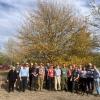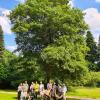Editor's Picks
Plant Focus
Charles Snyers d’Attenhoven
Published May 2016 International Oaks No. 27: 365–373
Introduction
The afternoon of Tuesday, October 20, was to be devoted to a tour of The Morton Arboretum. And that was not the whole afternoon, but about three hours with a stop at the Visitor Center. Quite a challenge given the area of the Arboretum: 1,700 acres. The program foresaw just two stops, not counting the Visitor Center. The Conference attendees were split into two groups and did not visit the sites in the same order.
The 8-acre plot at the west end of the Arboretum used to be farmland when Ray Schulenberg, then Curator of native plants at the Morton, decided to try to recreate a tallgrass prairie here in 1962. He started by planting one acre with seedlings he had raised from seed collected in remnant plots of native prairie found here and there in the area. The panel at the head of the trail indicated that tallgrass prairies, prior to the European settlement, covered 220,000 sq. miles in North America, “from Canada to Texas and Indiana to Nebraska.” Of course trees are scarce in prairies. By definition, said our guide, a prairie has less than one tree per acre or less than 10% canopy coverage. Nevertheless, about 40 species of trees are found in native prairies, 9 of which are dominant species. We did not see many trees in the prairie, just one Quercus macrocarpa and one Q. ellipsoidalis. Schulenberg Prairie is managed by burning the entire site once a year and covers today close to 100 acres.
After the Prairie, we boarded the Acorn Express that took us, after a stop at the Visitor Center, to the opposite side of the Arboretum to a place named the Quercus Collection which is by no means the full oak collection of the Morton since oaks are nearly everywhere in the Arboretum.
We stopped at the east end of the Quercus Collection which, I understand, contains the oldest planted oaks of the Arboretum (oaks still dominate the surrounding natural woodland areas and spontaneous native oaks are common). Many of the oaks in the immediate vicinity, usually large specimens, are native to Illinois.
After the short visit of the Quercus Collection, we walked through natural oak woodland back to the Acorn Express on the main road that runs around the Arboretum.
In the following pages let us stroll through this beautiful Arboretum in the company of Walt Whitman.















